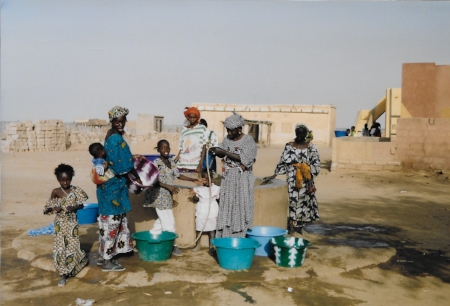(Nigeria, Africa Journal: November, 2000): Featuring Mrs. Janet Museveni, First Lady of Uganda, a couple of years ago turned out to be a great hit, and I knew the emphasis on Ethiopia and Project C.U.R.E.’s work there would likewise be a winner.
But no one from Ethiopia could break away to travel to Denver to speak at the banquet. Their political situation with Eritrea is tenuous enough that the leadership has been forced to stay very close to home. So the banquet committee volunteered me to speak for the event. I protested the prospect of speaking for a couple of reasons. First, I preferred continuing the tradition of having an international speaker for the event to give the occasion a little global importance and credibility. Second, we’ve been trying to broaden the leadership base of Project C.U.R.E. so that the identity and emphasis of the organization aren’t tied too closely to Jim Jackson.
The more I’m featured or put up front, the less effective we are at portraying the truth that the Project C.U.R.E. phenomenon has very little to do with me and everything to do with the people who have come together to carry out the mission of saving lives around the world through medical donations. To feature me as speaker, in my opinion, would mean taking some steps backward in our efforts to legitimately display the new levels and personalities of Project C.U.R.E. leadership. Project C.U.R.E. is healthy and strong and has long since grown past me in leadership procedures and position.
In order for Project C.U.R.E. to expand toward excellence in the future, the image and leadership base needs to move forward with lots of new blood.
But I was outvoted, and as I thought and prayed about an approach to take for my speech, it dawned on me that nearly everyone knows by now what Project C.U.R.E. is, what we do, where we do it, and under what circumstances we get involved in humanitarian activities in countries around the world. However, I couldn’t remember a time when I had articulated precisely why Project C.U.R.E. does what it does.
So at the banquet, I disclosed that, in my opinion, there is a true and positive correlation between the success of Project C.U.R.E. and the degree of relinquishment our volunteers and staff members bring to the organization. To explain this concept of relinquishment, I shared with our guests the story of Johnny Appleseed, who trudged across the countryside in the frontier territories of early America. In his grubby leather pouch, he carried apple seeds, knowing full well that one can count the number of seeds in an apple, but one cannot count the number of apples in a seed.
As the legendary frontiersman walked the land, he would take from his pouch the apple seeds, stoop to scoop out some soil, and drop the apple seeds into the earth. He relinquished his rights to his seeds in an on-purpose effort to grow apple trees, which would produce an abundant harvest of apples. Obviously he wouldn’t be there to claim the harvested apples, but he rested in the knowledge that pioneers and pilgrims who would follow him would benefit greatly as they reaped the fruits of his efforts of relinquishment.
I believe that same attitude of relinquishment, with no determined thought of personal return, is the key element in the extraordinary success of Project C.U.R.E.
I went on to explain that the true measure of greatness will always be determined by how well we care for others, not how much we accumulate for ourselves. Our culture places great importance on how high we can heap up wealth to fill the grocery carts of our lives in the shortest amount of time. Those who have the fullest carts at the checkout counter will win the prize. But even though we are programmed to grab things for ourselves, we can never get enough. Therefore, we almost have to go counterculture when we embrace the idea that success comes through giving and not through getting. In that respect, Project C.U.R.E. is counterculture.
The motivation behind our accumulation, I believe, should be the recognized opportunities for distribution, and we need organizations like Project C.U.R.E. as vehicles to allow us to experience such expressions. I challenged our guests to spend at least as much time in their lives on distribution as they do on accumulation. That would be a good place to start.
I expressed that more than likely, our greatest fulfillment in life is achieved through giving. Because what I hoard I can lose, and what I try to keep will be left behind and fought over by others. But what I give will continue to multiply and will forever generate a return—just like the trees Johnny Appleseed planted.
My final challenge to our dinner guests was for all of us to assume a posture of standing on our tiptoes in eager expectation of opportunities to give ourselves away and learn from personal experience in the years we have left the true thrill and satisfaction and joy of relinquishment.
The banquet took place on Saturday, November 18. That day, I experienced another rare thrill and opportunity. My grandson, Jace, is nine years old. He just finished his very first season of playing in an organized football league. Serendipitously, I was invited to bring a guest with me to a Denver Broncos open house and junior training camp at their Dove Valley headquarters. Of course, my chosen guest was Jace. At the open house, the Broncos staff showed us highlight films, fed us lunch, and gave us a complete tour of the Broncos’ workout rooms, weight rooms, locker rooms, classrooms, and practice fields. We even went to the artificial-turf field enclosed in a gigantic fabric air bubble, where the Bronco players and trainers put the fifty or so of us through fundamental drills and patterns.
Jace was absolutely beside himself with excitement. To complete his football dream day, he collected autographs from some of the players and even had his number-30 Broncos jersey personally signed by his football hero Terrell Davis, who wears a number-30 jersey in real life.
Out in the lobby, a professional photographer took a picture of Jace and his “papa” standing in front of the sterling-silver Vince Lombardi trophies presented to the Denver Broncos when they won their two world-championship Super Bowl victories. Recalling the following Vince Lombardi’s memorable quote really put me in the mood to stand in front of the Project C.U.R.E. crowd at the banquet and talk about relinquishment and changing our world:
After all the cheers have died down and the stadium is empty, after the headlines have been written, and after you are back in the quiet of your own room and the championship ring has been placed on the dresser and after all the pomp and fanfare have faded, the enduring thing that is left is the dedication to doing with our lives the very best we can to make the world a better place in which to live.
Maybe it was okay that I had to speak that night.




































